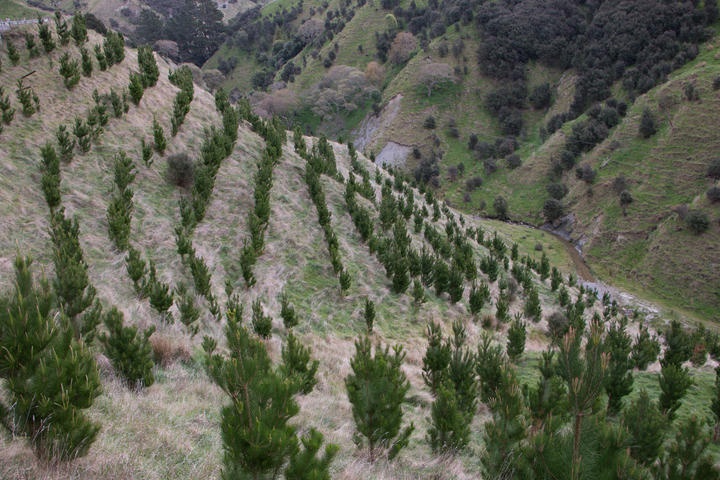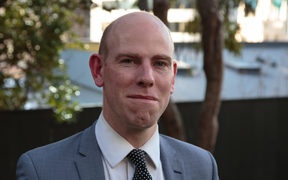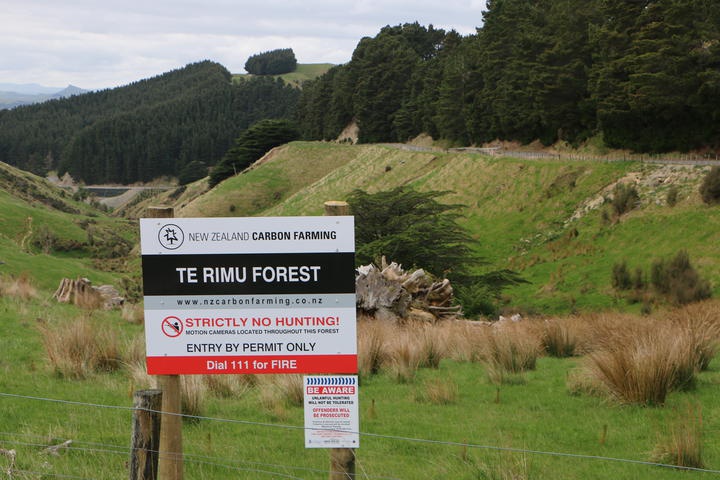Green Rush: Foreign forestry companies NZ's biggest landowners
Kate
Newton , Senior Journalist, In Depth
Guyon
Espiner, Investigative reporter, In Depth
The four largest private landowners in New Zealand are all foreign-owned forestry companies, an RNZ investigation has found.

Young radiata pine trees grow on a hillside in the Tararua district Photo: RNZ / Kate Newton
Despite a clampdown on some overseas investment, including a ban on residential sales to offshore buyers, the Labour-led government has actively encouraged further foreign purchases of land for forestry through a stream-lined 'special forestry test'.
Since the government was formed, the Overseas Investment Office (OIO) has approved more than $2.3 billion of forestry-related land sales - about 31,000 hectares of it previously in New Zealand hands.
Of that, about half has been sold via a streamlined 'special forestry test' introduced by the government last October.
Overall, nearly $5b of sensitive land has changed hands through the OIO since the government was formed.
The information comes from an RNZ investigation into land ownership in New Zealand.
Using Land Information New Zealand data, Companies Office searches and other research, RNZ has compiled a list of what we believe are the 100 biggest private landowners in New Zealand by area, not including the Crown and public entities (which control at least 28 percent of the land) or iwi.
Together, these landowners have freehold ownership of 1.42m ha of land - more than 10 percent of all privately-owned land and about 5 percent of New Zealand's total land area of 26.8m ha.
That comes close to the 6.7 percent of total land RNZ could conclusively identify as Māori-owned. Tūhoe, Ngāti Tūwharetoa, and the Central North Island grouping of eight iwi were the largest iwi landholders - although Tūhoe's holdings include Te Urewera, which has special independent legal status.
The analysis found at least 3.3 percent of New Zealand's land is foreign-owned.
Forestry companies dominate top 10
RNZ has only counted freehold land - that is, land owned outright. A separate analysis of lease titles found that many of the largest landowners were also large leaseholders. That includes forestry companies, who often buy surface rights - known as 'cutting rights' - to plant and harvest trees, but not the land itself.
Overseas forestry companies dominate the top of the freehold landowners list, taking the first four places, and account for six of the top 10 land-holders overall.
One of the companies, New Forests Asset Management, amassed its entire land portfolio of more than 77,000 ha in less than four years - bumping it from owning nothing in 2015, to being the country's third biggest private landowner today.
The company was allowed to go ahead with an application to buy more land - which was ultimately approved - while some of its earlier purchases were still under investigation by the Overseas Investment Office.
Forestry features prominently in the rest of the top 100, along with farming - due to the many large farming stations still in individual ownership. The various Christian denominations, including the Exclusive Brethren and Gloriavale, collectively own nearly 14,700ha - placing the church at 24th on the list.
Individual homeowners own very little of New Zealand's land mass. People who own five hectares or less of land - a generous estimate of what might count as a single residential property, such as a lifestyle block - collectively own about 1.5 percent of New Zealand.
Using a more stringent 'quarter-acre test' and only counting individuals and entities who own 0.1 hectares or less, it drops to less than half a percent.
Data underlines inequality
Max Rashbrooke, an inequality researcher at Victoria University's Institute for Governance and Policy Studies, said the data underlined "the enormous wealth inequality in New Zealand".
"You don't have distributed ownership of land in any sort of economically meaningful sense when you have such a dominance ... by just a hundred landowners and companies."
In the late 19th century, New Zealand governments had sought to break up some of the very large privately-owned estates, Mr Rashbrooke said.

Max Rashbrooke Photo: Matt Bialostocki
"This tends to show that that vision hasn't really been realised, in a substantial sense."
The small amount of land in Māori ownership - much of it returned via Treaty settlements - was "a stark reminder of the effects of colonisation, given that Māori used to own 100 percent of the land", he said.
The data reinforced the argument for a capital gains tax, he said.
"Quite a few of these individuals and companies will be making their fortunes through capital gains… I would see these figures as strengthening the case for taxing wealth in New Zealand in some form or another."
One positive aspect was how much land in New Zealand remained in some kind of public ownership, Mr Rashbrooke said.
"We've preserved a lot of land, through national parks and regional parks, in public ownership.
"That's a good thing, because it means that those things are open to the enjoyment of all… It preserves the idea that you can have access to these wonderful landscapes based on your standing as a citizen, not on your ability to pay."
English researcher and author Guy Shrubsole, who conducted a years-long analysis of land ownership in the UK, said that was in stark contrast to the situation there, where only about 8.5 percent of land was in some kind of public ownership.
"It looks like, although everywhere in the world experienced a neoliberal revolution from the 1970s and 80s onwards, perhaps that didn't result in quite the same public fire-sale of land [in New Zealand] as we've seen in England and the UK."
Of the land RNZ did identify as privately owned, half was concentrated among a tiny group of 4600 people or entities - equivalent to 0.1 percent of New Zealand's population.
That was remarkable and "very scary", Shrubsole said.
"I was expecting it to be much more widespread in terms of ownership."
The 10 largest freehold landowners in New Zealand are:
• Taumata Plantations Limited (101,854 hectares): Taumata Plantations purchased the former Carter Holt Harvey forests and has kept a significant majority of the land, recently on-selling some of it to New Zealand companies. The company is ultimately owned by several overseas investment funds and banks. The largest shareholder is Manulife, a major Canada insurance company.
• Tiong family (77,686 hectares): The Malaysia-based, family-owned Tiong Group own forestry, media and property assets around the world. Their land holdings in New Zealand include the Ernslaw One forests, New Zealand King Salmon, and land owned by their property and land development company, The Neil Group.
• New Forests Asset Management (77,465 hectares): New Forests is an Australia-based assets management company that operates several investment funds in New Zealand, owned by several subsidiaries. It has amassed its forestry land portfolio in less than four years, starting with purchases in the Wairarapa in 2016. An Overseas Investment Office investigation into one subsidiary's purchases resulted in a formal warning, an $80,000 charity donation and $20,000 in costs.
• Matariki Forests (73,509 hectares): Another forestry company, three-quarter-owned by the US-based Rayonier. The remaining quarter of the company's shareholding is owned by an Australian-registered company, Waimarie Forests Pty Limited.
• Roberts and Apatu families (41,296 hectares combined): The intermarried Roberts and Apatu families own two large stations and some additional land on the Napier-Taupō road, which they have collectively farmed for nearly a century.
• Michael Spencer (35,942 hectares): Part of the wider Spencer family, one of New Zealand's wealthiest families. Spencer's properties include Lochinver Station, which he bought after a highly-publicised bid from a Chinese company, Shanghai Pengxin, was rejected by the government.
• Port Blakely Limited (35,889 hectares): Another US-owned forestry company.
• Global Forest Partners LLC (33,706 hectares): Global Forest Partners, registered in the Cayman Islands, is the ultimate owner of two private investment funds that own forestry land in New Zealand.
• New Zealand Carbon Farming (28,365 hectares): Ultimate holding company with more than a dozen subsidiary companies. The joint shareholders include managing director Matt Walsh and another director, Bruce Miller. The company describes its core business as a supplier of bulk carbon credits to large energy and oil companies. It has recently purchased and planted radiata pine trees on several large former farms in the Tararua district.
• Wairakei Pastoral Limited (27,634 hectares): Owned by Auckland rich-listers Trevor Farmer, Ross Green and Mark Wyborn. The company's major land-holding is a 26,000ha farm near Taupō. About half of the property is leased to Landcorp.

Former Te Rimu Station in the Tararua district has been purchased by New Zealand Carbon Farming - the ninth largest private landowner in the country - and converted to forestry Photo: RNZ / Kate Newton
How RNZ analysed the data
The figures in the list above have been compiled using Land Information New Zealand data and may not account for some land transfers that have not been documented in LINZ's database.
Ownership has been aggregated by the ultimate owner wherever possible - for example, if an individual owns land in their own name, and also via companies they own or co-own (with at least a 50 percent shareholding), that land has been aggregated under a single name, iwi, or entity.
RNZ carried out extensive cross-checking, using the Companies Office website and other resources, to verify the identities of individuals and entities, and ensure individuals with similar names did not have their land-holdings aggregated by mistake.
To determine whether land was publicly-owned, RNZ aggregated any land where the ownership title was in the name of a public entity (the government, public schools, councils, council-owned organisations and so on). Where there was no ownership title, RNZ followed a similar methodology to one developed by Auckland Council researchers last year.
RNZ was unable to categorise about 9 percent of the land in LINZ's database, because it had no ownership title and no other reliable information about the land's use.
Bodies of water and roads have been excluded from the database, along with leasehold titles.
This story is part of a series, Green
Rush, looking at forestry and land ownership in New Zealand.
You can read more throughout the
week.



 Gordon Campbell: On Justin Trudeau’s Demise, In A Global Context
Gordon Campbell: On Justin Trudeau’s Demise, In A Global Context Ramzy Baroud: Israel Destroyed Gaza ‘For Generations To Come’ And The World Stayed Silent
Ramzy Baroud: Israel Destroyed Gaza ‘For Generations To Come’ And The World Stayed Silent Binoy Kampmark: Detained Without Charge - Eleven Yemenis Leave Guantánamo
Binoy Kampmark: Detained Without Charge - Eleven Yemenis Leave Guantánamo Ramzy Baroud: The War Criminal 'Victim' - Netanyahu’s Inevitable Fate
Ramzy Baroud: The War Criminal 'Victim' - Netanyahu’s Inevitable Fate Martin LeFevre - Meditations: From Symbolic Consciousness To Insight Consciousness
Martin LeFevre - Meditations: From Symbolic Consciousness To Insight Consciousness Binoy Kampmark: Arresting And Killing Greenies - Targeting Climate Change Protests
Binoy Kampmark: Arresting And Killing Greenies - Targeting Climate Change Protests